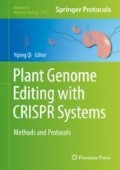Abstract
The development of the Clustered Regularly Interspersed Short Palindromic Repeats (CRISPR)/CRISPR-associated (Cas9) system has advanced genome editing and has become widely adopted for this purpose in many species. Its efficient use requires the method adjustment and optimization. Here, we show the use of a model carrot callus system for demonstrating gene editing via CRISPR/Cas9 targeted mutagenesis. The system relies on the utilization of carrot tissue accumulating anthocyanin pigments responsible for a deep purple cell color and generation of knockout mutations in the flavanone-3-hydroxylase (F3H) gene in the anthocyanin biosynthesis pathway. F3H mutant cells targeted by Cas9/gRNA complexes are not able to synthesize anthocyanins and remain white, easily visually distinguished from purple wild-type cells. Mutations are either small indels or larger chromosomal deletions that can be identified by restriction fragment analysis and sequencing. This feasible system can also be applied for validating efficiency of CRISPR/Cas9 vectors.
Access this chapter
Tax calculation will be finalised at checkout
Purchases are for personal use only
References
Baranski R (2008) Genetic transformation of carrot (Daucus carota) and other Apiaceae species. Transgenic Plant J 2:18–38
Iorizzo M, Ellison S, Senalik D, Zeng P, Satapoomin P, Huang J, Bowman M, Iovene M, Sanseverino W, Cavagnaro P, Yildiz M, Spooner DM, Simon PW et al (2016) A high-quality carrot genome assembly provides new insights into carotenoid accumulation and asterid genome evolution. Nat Genet 48:657–666
Klimek-Chodacka M, Oleszkiewicz T, Lowder LG, Qi Y, Baranski R (2018) Efficient CRISPR/Cas9 based genome editing in carrot cells. Plant Cell Rep 37:575–558
Andersson M, Turesson H, Nicolia A, Fält AS, Samuelsson M, Hofvander P (2017) Efficient targeted multiallelic mutagenesis in tetraploid potato (Solanum tuberosum) by transient CRISPR-Cas9 expression in protoplasts. Plant Cell Rep 36:117–128
Meng Y, Hou Y, Wang H, Ji R, Liu B, Wen J, Niu L, Lin H (2017) Targeted mutagenesis by CRISPR/Cas9 system in the model legume Medicago truncatula. Plant Cell Rep 36:371–374
Jinek M, Chylinski K, Fonfara I, Hauer M, Doudna JA, Charpentier E (2012) A programmable dual-RNA-guided DNA endonuclease in adaptive bacterial immunity. Science 337:816–821
Anders C, Niewoehner O, Duerst A, Jinek M (2014) Structural basis of PAM-dependent target DNA recognition by the Cas9 endonuclease. Nature 513:569–573
Belhaj K, Chaparro-Garcia A, Kamoun S, Nekrasov V (2013) Plant genome editing made easy: targeted mutagenesis in model and crop plants using the CRISPR/Cas system. Plant Methods 9(1):39
Zaidi SS, Tashkandi M, Mansoor S, Mahfouz MM (2016) Engineering plant immunity: using CRISPR/Cas9 to generate virus resistance. Front Plant Sci 7:1673
Petrussa E, Braidot E, Zancani M, Peresson C, Bartolini A, Patui S, Vianello A (2013) Plant flavonoids—biosynthesis, transport and involvement in stress responses. Int J Mol Sci 14:14950–14973
Cheynier V, Comte G, Davies KM, Lattanzio V, Martens S (2013) Plant phenolics: recent advances on their biosynthesis, genetics, and ecophysiology. Plant Physiol Biochem 72:1–20
Zuker A, Tzfira T, Ben-Meir H, Ovadis M, Shklarman E, Itzhaki H et al (2002) Modification of flower color and fragrance by antisense suppression of the flavanone 3-hydroxylase gene. Mol Breed 9:33–41
Gamborg OL, Miller RA, Ojima A (1968) Nutrient requirements of suspension cultures of soybean root cells. Exp Cell Res 50:151–158
Lowder LG, Zhang D, Baltes NJ, Paul JW, Tang X, Zheng X, Voytas DF, Hsieh TF, Zhang Y, Qi Y (2015) A CRISPR/Cas9 toolbox for multiplexed plant genome editing and transcriptional regulation. Plant Physiol 169:971–985
Rogers SO, Bendich AJ (1988) Extraction of DNA from plant tissues. In: Plant molecular biology manual, vol. A6, p. 1–10.
Curtis MD, Grossniklaus U (2003) A gateway cloning vector set for high-throughput functional analysis of genes in planta. Plant Physiol 133:462–469
Acknowledgments
This work was supported by the National Science Centre, Poland (UMO-2013/09/B/NZ9/02379) and by the Ministry of Science and Higher Education of the Republic of Poland.
Author information
Authors and Affiliations
Corresponding author
Editor information
Editors and Affiliations
Rights and permissions
Copyright information
© 2019 Springer Science+Business Media, LLC, part of Springer Nature
About this protocol
Cite this protocol
Klimek-Chodacka, M., Oleszkiewicz, T., Baranski, R. (2019). Visual Assay for Gene Editing Using a CRISPR/Cas9 System in Carrot Cells. In: Qi, Y. (eds) Plant Genome Editing with CRISPR Systems. Methods in Molecular Biology, vol 1917. Humana, New York, NY. https://doi.org/10.1007/978-1-4939-8991-1_15
Download citation
DOI: https://doi.org/10.1007/978-1-4939-8991-1_15
Published:
Publisher Name: Humana, New York, NY
Print ISBN: 978-1-4939-8990-4
Online ISBN: 978-1-4939-8991-1
eBook Packages: Springer Protocols

